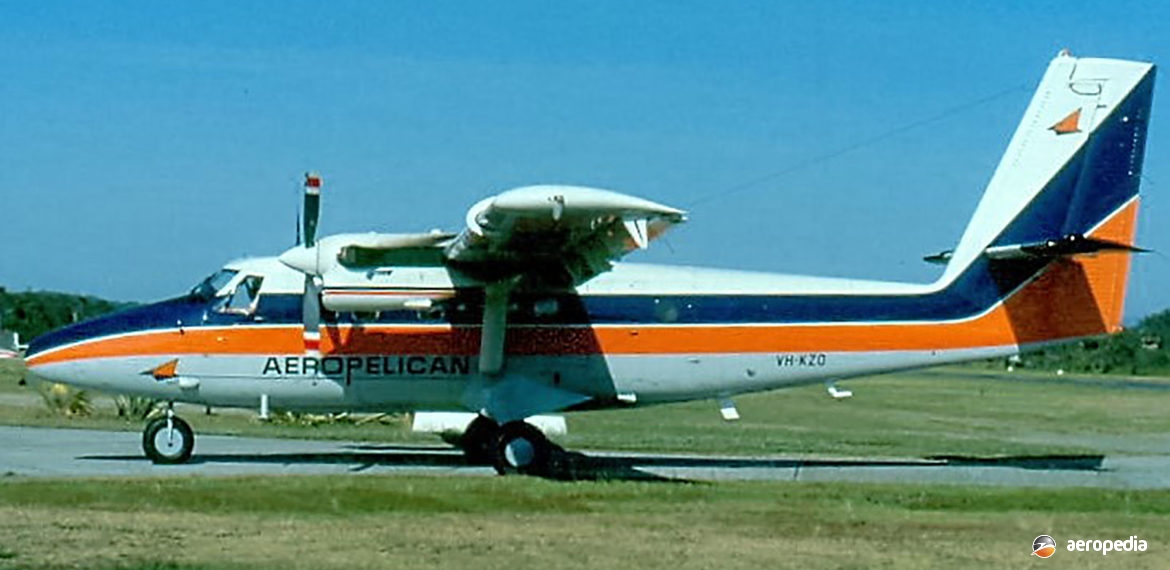Photograph:
de Havilland DHC-6-320 Twin Otter VH-KZO (c/n 753) of Aero Pelican at Belmont, NSW in November 1982 (David C Eyre)
Country of origin:
Canada
Description:
Light twin-engine utility transport and third-level airliner
Power Plant:
Two 486 kw (652 eshp) Pratt & Whitney PT6A-27 turboprops
Specifications:
- Wingspan: 19.81 m (65 ft)
- Length: 15.77 m (51 ft 9 in)
- Height: 5.66 m (18 ft 7 in)
- Wing area: 39.02 m² (420 sq ft)
- Max cruising speed at 3,048 m (10,000 ft): 324 km/h (202 mph)
- Economical cruising speed at 3,048 m (10,000 ft): 277 km/h (172 mph)
- Stalling speed with flaps: 112 km/h (70 mph)
- Initial rate of climb: 486 m/min (1,600 ft/min)
- Single-engine climb: 103 m/min (340 ft/min)
- Service ceiling: 8,140 m (26,700 ft)
- Range with max payload: 150 km (115 miles)
- Range with max fuel: 1,775 km (1,103 miles)
- Take-off run: 262 m (860 ft)
- Landing run: 290 m (950 ft)
- Empty weight: 3,320 kg (7,320 lb)
- Max payload weight: 2,010 kg (4,330 lb)
- Loaded weight: 5,670 kg (12,500 lb
History:
Following the success of the earlier DHC-6 Twin Otter Series 100 and 200, de Havilland Canada moved to the Series 300, production of this model beginning with the 231st aircraft off the production line, this model introducing the more powerful PT6A-27 engines and making it possible to increase max take-off weight by 454 kg (1,000 lb). By mid 2008 more than 500 examples of the DHC-6-300 series had been delivered.
A special variant known as the Series 300S was developed for use on experimental services between STOL airports in Montreal and Ottawa, modification to these aircraft including the installation of an anti-skid braking system, emergency as well as high-capacity brakes, wing spoilers and other improvements to the electrical, fire protection and hydraulic systems. Accommodation was limited to 11 passengers in standard airline seats whereas standard seating in a commuter layout was for 20 passengers. Floatplane and wheel/ski variants were produced, and a ventral pod was developed carrying up to 272 kg (600 lb) of baggage or freight.
By the end of 1986, 826 DHC-6 Twin Otters of all models had been sold, production ceasing in 1988 after 115 Series 100, 115 Series 200 and 614 Series 300 aircraft had been completed, the production facility switching in favour of the de Havilland Dash-8 series.
The DHC-6-300M was introduced in 1982, this being a multi-purpose military variant, developed as a dedicated military aircraft for maritime reconnaissance, counter-insurgency / light strike duties, and as a multi-purpose light transport. All floatplane versions retained the shorter fuselage nose of the original Twin Otter Series 100 and were fitted with wing fences and small auxiliary fins.
As noted in the DHC-6-100 and 200 article, the type has been used extensively in Australia and New Guinea by companies such as Ansett/MAL, TAA, East West Airlines for a period, and Aero Pelican in Sydney, NSW which used the type on commuter services to Belmont, NSW.
Australian aviator Dick Smith, on behalf of his company Dick Smith Adventure Pty Ltd, imported a DHC-6-320 Twin Otter VH-SHW (c/n 721 – ex N999PG) in March 1988 for an Australian Geographic / Australian National Antarctic Research Expedition (ANARE) trip. On 6 November 1988 the aircraft was flown from Hobart, TAS to the Australian Antarctic Territory, landing near Casey Station. It was registered VH-SHW to honour the Australian Antarctic explorer Sir Hubert Wilkins. On 16 November 1988 it made a landing on the sea ice off Davis Station to commemorate the 60th anniversary of Wilkins making the first ever flight in the Antarctic. The aircraft was later exported to Air Seychelles in February 1990 as S7-AAT.
Twin Otters have also operated in the Solomon Islands, Fiji and other areas of the Pacific. In later years a couple of early models were used by organisations such as the Sydney Skydiving Centre at Wilton, NSW.
In 2008 a company in Canada announced it was proposing to place the Twin Otter back in production in revised form. This company, Viking Air, used a DHC-6-300 and modified it to DHC-6-400 configuration, the prototype of this model with PT6A-34 turboprops flying for the first time on 21 October 2008. This aircraft had a Honeywell Primus Apex avionics suite and Wipline 13000 amphibious floats. At the time of the first flight orders had been received for 40 new-build aircraft.
On 4 January 2013 a DHC-6-300 on amphibious floats was ferried from Denpasar in Indonesia to Bankstown, NSW for Unknown Destination Services of Southport, QLD, becoming VH-AQU (c/n 557 – ex PK-BRR, C-FWVV, N208JE, YV-184CP), but was exported to Croatia as 9A-TOA on 15 May 2014.
The last DHC-6 Twin Otter in New Zealand was ZK-MCO which was a DHC-6-310 (c/n 530) exported as N530JM, which was delivered to the Maldives where it became 8Q-HIG and was fitted with floats.
An interesting visitor to New Zealand was DHC-6-300 Twin Otter C-GKBO of Ken Borek Air which was used to fulfil a project to map the exact position of the sub-Antarctic Snares and Solander Islands for Land Information New Zealand (LINZ) on behalf of the US Army Corps of Engineers, the aircraft using Scanning Hydrographic Operations Airborne Lidar System (SHOALS) mounted on the aircraft.

